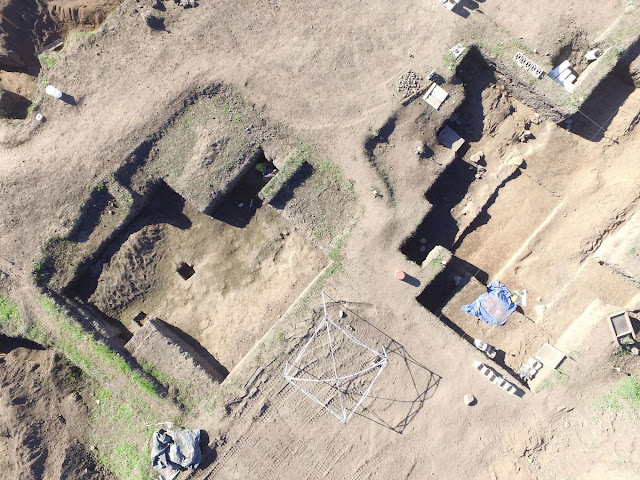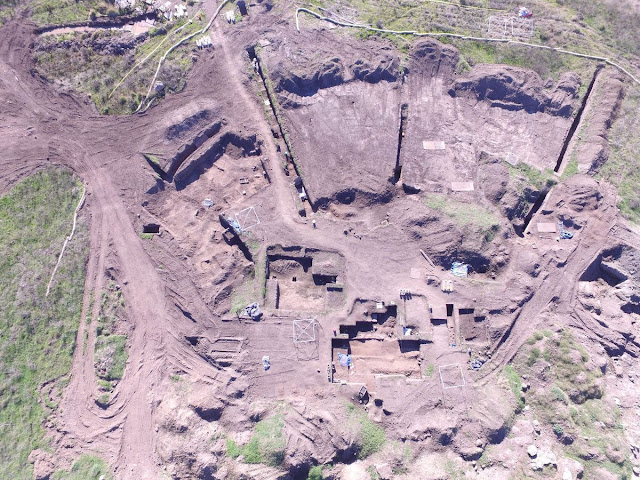Almost a year after it began, archaeologists continue excavating a large site in downtown Napa – one that could have been home to Native Americans as long as 2,000 years ago.
 |
| Credit: Napa Valley Register |
Because the dig is occurring at a heavily traveled intersection on the edge of downtown Napa, the project has provoked considerable public interest.
Kevin Teague, a local attorney counseling the site owner, Palm Hill Inc., said excavation was going well.
The team is almost complete with the required excavation work, which must be completed before the owners can proceed with construction of the hotel, he wrote in an email statement on Friday.
“This portion of the site was identified years ago, well before the original hotel was approved, as an archaeological site,” Teague noted. “Because of this, our federal and other permits required the work you see out there to be completed prior to the excavation work for the parking and utilities.”
While the property is secured by locked chain link fencing and other security measures, images taken in December above the area by a drone reveal an extensive grouping of pits and trenches.
After reviewing the drone photographs, Christopher D. Dore, a registered professional archaeologist with Heritage Business International, described the excavation work as extensive.
“This is a major project,” said Dore.
Dore, who lives in Arizona, is not working on the Napa excavation, but he agreed to share some observations about what is likely happening at the property.
“Here you have a large archaeological site that is on the banks of the Napa River,” he said. “It’s probably a village site or habitation site,” so archaeologists would expect to find remains of fireplaces or hearths, and possibly human remains.
“This is an important, significant site,” Dore said.
Dore estimated 10 to 30 archaeologists could be working on the site, in addition to one or more Native American monitors.
 |
| Credit: Napa Valley Register |
“I have no idea what they are finding,” he said. But, from the scale of it – and because workers have been on the site since April – “It’s not your average project.”
“This is not a small site,” said Alexandra Greenwald, Ph.D., a postdoctoral fellow at the Center for Evolution and Medicine at Arizona State University, who also reviewed the drone images.
Greenwald, who is not associated with this project, said it would not be surprising to find evidence of artifacts and occupation in such an area.
“People lived there,” including Native Americans, “and for the same reasons Napans live there now,” she said. “It was a nice place.”
According to Greenwald, artifacts typically found at such a site in Napa Valley could include animal bones, shells or byproducts of people making stone or other tools.
Greenwald said the materials that stone tools were made of can help illuminate the trade relationships residents had. Shaking dirt through screens can reveal the kind of foods people ate. Rocks cracked from being used for cooking in hearths are also common artifacts.
Teague explained that any artifact identification will occur following completion of the excavation work.
“It would not be appropriate for me or ownership as to speculate on what may have been there until the professionals have completed their analytical work,” the agencies complete their reviews and “the Mishewal-Wappo Tribe is in agreement,” he said. “This is all normal course for this type of project.”
During a phone call on Thursday, Scott Gabaldon, chairman of the Mishewal-Wappo Tribe, declined to be interviewed for this story. The Mishewal-Wappo are an indigenous people of Napa Valley and Northern California.
To keep track of where artifacts are found, holes are typically dug in one-meter square increments using a grid system, said Greenwald.
The long trenches seen in the photos represent a common way to “sample” an area. If it is too time- or labor-intensive to excavate huge squares of earth, long trenches can be used to test larger areas instead, she said.
Trenching might also be done because these archaeologists have been informed where a road or building will be created, so therefore that space would need to be excavated for any artifacts that might be affected by the development.
 |
| Credit: Napa Valley Register |
Security is a typical concern at a project like this, said the archaeologists.
To prevent looting or disturbing the Napa site, security fencing and “no trespassing” signs have been installed.
“It’s important not to interfere with archaeology sites, the archaeologists or the Native American descendants who are working there,” Greenwald said. “These are trained professionals who are doing their jobs.”
Dore said while the artifacts that are eventually identified may seem “mundane” to the average person, “securing that and keeping people from looting is important.”
The archaeologist explained that the information gained from the excavation doesn’t come directly from the artifact. “It really comes from the relationship of that artifact to other artifacts and the setting where it was found.”
“It’s a huge puzzle for us,” said Dore.
If that setting is disturbed, the context is lost.
Cultural sensitivity is another key element of such a project.
“For many native groups it is a horrible thing if their ancestors’ remains are being exhumed,” noted Greenwald.
Even if remains are not identified, “It’s important to respect the wishes and beliefs of the Native American community you are working with.” Such work shouldn’t become a public spectacle, she said.
This excavation could be “very personal and sensitive,” Dore said.
In addition, everyone involved at the excavation has a different interest, he noted. That includes the developer, archaeologists, the scientific community and Native American representatives.
“Often times those interests can conflict,” or become emotional, he pointed out.
According to the California Department of Parks and Recreation, several state and federal laws protect Native American historic and cultural resources from vandalism and looting.
 |
| Credit: Napa Valley Register |
These cultural features can include Native American graves and artifacts; traditional cultural landscapes; natural resources used for food, ceremonies or traditional crafts; and places that have special significance.
When projects are proposed in areas where Native American cultural features are likely to be affected, one way to avoid damaging them is to have a Native American monitor present.
If Native American artifacts are found and are believed to be burial items, the NAHC or local law enforcement should be contacted. If remains are found, the county coroner would be contacted.
“I’m not aware they’ve found any human remains there,” Capt. Steve Blower of the Napa County Sheriff’s Office said Friday.
While some people may feel the site should remain undisturbed, the reality is that it is private property, said Dore. Even though artifacts may have been found, once the landowner fulfills CEQA and other requirements, such developments typically go forward.
Dore said that sometimes archaeologists involved with such a project are asked by the developer not to discuss the work with outsiders.
After the excavation and study is done, a report will be deposited in the California Historical Resources Information System which is an information management system run by the state. However, “There are probably thousands of hours of analysis and writing that will need to be done,” he estimated. The report itself could take months or even years to file.
The city first approved the luxury hotel in 2008, clearing the way for a five-star lodging with a restaurant, spa, boutique shopping and underground valet parking. The project was to have been a Ritz-Carlton.
But the Great Recession cut off financing and stalled the project, which has passed through several ownership changes since.
Palm Hill, the current owner, acquired the property in 2013 from River House Land Co.
Dore said that this kind of excavation and dig may seem unusual to Napans, but archaeology “isn’t just big pyramids in Egypt.”
In fact, there’s a good chance that artifacts can be found on the property of anyone who lives in the area, he said.
“There is a very rich archaeological record” in our area, Dore said.
“It’s underneath people’s feet every day. The evidence of our past is pretty much everywhere.”
As to the next steps for the hotel development, Teague said, “We hope to complete our infrastructure permits with the city and various agencies so the major portion of the hotel construction can get started this spring.”
Author: Jennifer Huffman | Source: Napa Valley Register [January 09, 2018]
